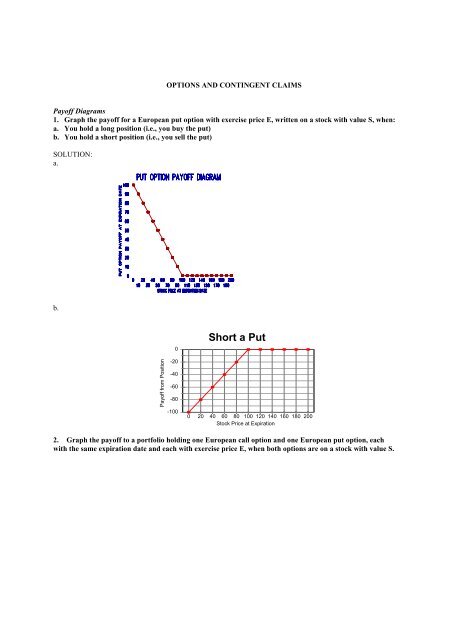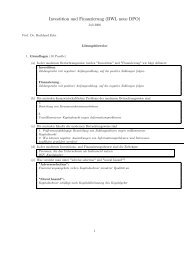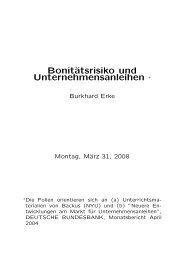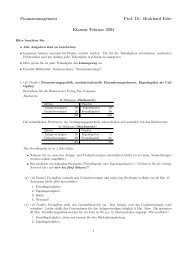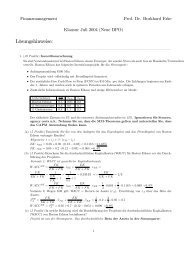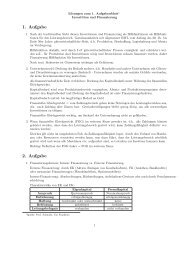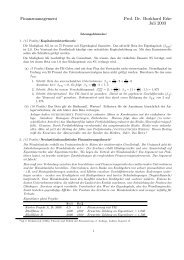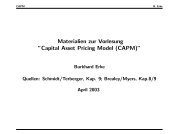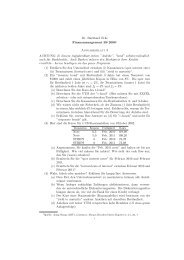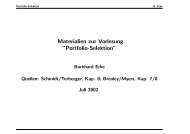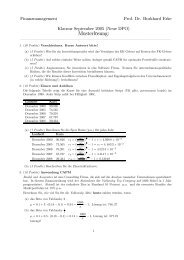Short a Put - Burkhard Erke
Short a Put - Burkhard Erke
Short a Put - Burkhard Erke
Create successful ePaper yourself
Turn your PDF publications into a flip-book with our unique Google optimized e-Paper software.
OPTIONS AND CONTINGENT CLAIMS<br />
Payoff Diagrams<br />
1. Graph the payoff for a European put option with exercise price E, written on a stock with value S, when:<br />
a. You hold a long position (i.e., you buy the put)<br />
b. You hold a short position (i.e., you sell the put)<br />
SOLUTION:<br />
a.<br />
b.<br />
Payoff from Position<br />
0<br />
-20<br />
-40<br />
-60<br />
-80<br />
-100<br />
<strong>Short</strong> a <strong>Put</strong><br />
0 20 40 60 80 100 120 140 160 180 200<br />
Stock Price at Expiration<br />
2. Graph the payoff to a portfolio holding one European call option and one European put option, each<br />
with the same expiration date and each with exercise price E, when both options are on a stock with value S.
SOLUTION:<br />
Payoff at Expiration<br />
100<br />
80<br />
60<br />
40<br />
20<br />
0<br />
Long a Call and a <strong>Put</strong><br />
a Straddle<br />
0 20 40 60 80 100 120 140 160 180 200<br />
Stock Price at Expiration<br />
Investing with options<br />
3. The risk-free one –year rate of interest is 4%, and the Globalex stock index is at 100. The price of oneyear<br />
European call options on the Globalex stock index with an exercise price of 104 is 8% of the current<br />
price of the index. Assume that the expected dividend yield on the stocks in the Globalex index is zero. You<br />
have $1million to invest for the next year. You plan to invest enough of your money in one-year T-bills to<br />
insure that you will at least get back your original $1 million, and you will use the rest of your money to buy<br />
Globalex call options.<br />
a. Assuming that you can invest fractional amounts in Globalex options, show the payoff diagram for your<br />
investment. Measure the Globalex index on the horizontal axis and the portfolio rate of return on the<br />
vertical axis. What is the slope of the payoff line to the right of an index value of 104<br />
b. If you think that there is a probability of .5 that the Globalex index a year from now will be up 12%, a<br />
probability of .25 that it will be up 40%, and a probability of .25 that it will be down 20%, what is the<br />
probability distribution of your portfolio rate of return<br />
SOLUTION:<br />
a. To insure that you will at least get back your original $1 million, you need to invest<br />
$1,000,000 $1,000,000<br />
= = $961,538.46<br />
1 + r f<br />
1 + .04<br />
in T-bills.<br />
You can buy<br />
$1,000,000 − $961,538.46 $38,461.54<br />
=<br />
= 4807.69<br />
.08 × 100<br />
8<br />
options.<br />
b.<br />
The slope of the payoff line to the right of an index value of 104 is 4807.69, as seen from the graph:<br />
Probability of Globalex Stock Index change 0.5 0.25 0.25<br />
Percentage change of Global Stock index 12% 40% -20%<br />
Next Year's Globalex Stock Index 112 140 80<br />
Payoff of 4807.69 shares of options 38461.52 173076.8 0<br />
Payoff of your portfolio 1038462 1173077 1000000<br />
Portfolio rate of return 3.85% 17.31% 0
<strong>Put</strong>-Call Parity<br />
4.<br />
a. Show how one can replicate a one-year pure discount bond with a face value of $100 using a share of<br />
stock, a put and a call.<br />
b. Suppose that S=$100, P=$10, and C=$15. What must be the one-year interest rate<br />
c. Show that if the one-year risk-free interest rate is lower than in your answer to part b, there would be an<br />
arbitrage opportunity. (Hint: The price of the pure discount bond would be too high).<br />
SOLUTION:<br />
a. To replicate a one-year pure discount bond with a face value of $100, buy a share of stock, and a European put<br />
with exercise price $100, and sell a European call with an exercise price $100.<br />
b. S = $100, P = $10, and C = $15.<br />
E/(1+r) = S + P- C<br />
$100/(1+r) = $100 + $10 - $15 = $95<br />
r = 100/95 -1 = .053 or 5.3%<br />
c. If r = 4%, then one could make risk-free arbitrage profits by borrowing at 4% and investing in synthetic 1-year<br />
pure discount bonds consisting of a share of stock, a European put with exercise price $100, and a short<br />
position in a European call with an exercise price $100. The synthetic bond would cost $95 and pay off $100 at<br />
maturity in 1 year. The principal and interest on the $95 it costs to buy this synthetic bond would be $95 x 1.04<br />
= $98.8. Thus there would be a pure arbitrage profit of $1.20 per bond a year from now with zero initial outlay<br />
of funds.<br />
5. A 90-day European call option on a share of the stock of Toshiro Corporation is currently trading at<br />
2,000 yen whereas the current price of the share itself is 2, 400 yen. 90-day zero-coupon securities issued by<br />
the government of Japan are selling for 9, 855 yen per 10, 000 yen face value. Infer the price of a 90-day<br />
European put option on this stock if both the call and put have a common exercise price of 500 yen.<br />
SOLUTION:<br />
Using the expression for put-call parity, P = -S + E/(1+r) T + C<br />
S is the share price, P is the price of the put, C is the price of the call and E is the common exercise price.<br />
Since government bonds are selling at . 9855 per 1 yen of face value, this is the discount factor for computing the<br />
PV of the exercise price. There is no need to compute the riskless rate, r.<br />
Substituting in the parity equation we get:<br />
P = −2,400 + 500 x .9855 +2,000 = 92.75 yen<br />
6. Gordon Gekko has assembled a portfolio consisting of ten 90-day US Treasury bills, each having a face<br />
value of $1, 000 and a current price of $990.10, and 200 90-day European call options, each written on a<br />
share of Paramount stock and having an exercise price of $50.00. Gekko is offering to trade you this portfolio<br />
for 300 shares of Paramount stock, which is currently valued at $215.00 a share. If 90-day European put<br />
options on Paramount stock with a $50.00 exercise price are currently valued at $25.00,<br />
a. Infer the value of the calls in Gekko’s portfolio.<br />
b. Determine whether you should accept Gekko’s offer.<br />
SOLUTION:<br />
a. Using put-call parity, the current price of a call is found to be approximately $190.50 as follows:<br />
C = S − E/(1+r) T + P = $215 − $50 x .9901 + $25 = $190.495<br />
b. The value of Gekko’s portfolio is 10 x $990.10 + 200 x $190.495 = $48,000<br />
But the value of 300 shares is $64,500. We should reject Gekko’s offer.
7. The stock of Kakkonen, Ltd., a hot tuna distributor, currently lists for $500.00 a share, whereas one-year<br />
European call options on this stock, with an exercise price of $200.00, sell for $400.00 and European put<br />
options with a similar expiration date and exercise price sell for $84.57.<br />
a. Infer the yield on a one-year, zero-coupon U.S. government bond sold today.<br />
b. If this yield is actually at 9%, construct a profitable trade to exploit the potential for arbitrage.<br />
SOLUTION:<br />
a. Using put-call parity, we can infer the riskless yield to be approximately 8.36% as follows:<br />
A portfolio consisting of a share of the stock, a put, and a short position in a call is equivalent to a 1-year T-bill<br />
with a face value of E. Therefore the price of such a T-bill would have to be $184.57:<br />
E/(1+r) T = S + P− C = $500.00 +$84.57 −$400.00 = $184.57<br />
1+r = 200/184.57 = 1.0836<br />
r = .0836 or 8.36%<br />
b. There are many ways to exploit the violation of the Law of One Price to make arbitrage profits. Since the riskfree<br />
interest rate is 9%, and the implied interest rate on the replicating portfolio is 8.36%, we could go short the<br />
replicating portfolio and invest the proceeds in T-bills. For example, at current prices, short-sell a “unit”<br />
portfolio, which consists of long positions in one put and one share and writing one call, to earn immediate<br />
revenue of $184.57. The portfolio you sold short requires payment of $200 one year from now. If you invest<br />
the $184.57 in one-year T-bills you will have 1.09x $184.57 = $201.18 a year from now. Thus you will earn a<br />
risk-free arbitrage profit of $1.18 with no outlay of your own money.<br />
Two-State Option Pricing<br />
8. Derive the formula for the price of a put option using the two-state model.<br />
SOLUTION:<br />
To price the put option, we create a synthetic option by selling short a fraction (denote the fraction “a”) and lend $b<br />
in risk-free asset. Denote the price of the stock S, the price of the put option P, the stock price when the next period<br />
is an “up” to be uS, the stock price when the next period is a “down” to be dS, the payoffs of the put option in each<br />
state Pu and Pd, and the risk-free interest r.<br />
We solve for (a, b) in 1)<br />
and 2)<br />
We find:<br />
and<br />
− u × S × a + (1 + r)<br />
× b =<br />
− d × S × a + (1 + r)<br />
× b =<br />
Pu<br />
− Pd<br />
a = −<br />
( u − d)<br />
× S<br />
u × Pd<br />
− d × Pu<br />
b =<br />
( u − d)<br />
× (1 + r)<br />
So that the price of the put option<br />
P<br />
1 ⎡⎛1+<br />
r − d)<br />
⎞ ⎛ u −1−<br />
r ⎞<br />
−a<br />
× S + b = × ⎢⎜<br />
⎟× Pu<br />
+ ⎜ ⎟× P<br />
(1 + r)<br />
⎣⎝<br />
u − d ⎠ ⎝ u − d ⎠<br />
=<br />
d<br />
P u<br />
P d<br />
⎤<br />
⎥<br />
⎦
9. The share value of Drummond, Griffin and McNabb, a New Orleans publishing house, is currently<br />
trading at $100.00 but is expected, 90 days from today, to rise to $150.00 or to decline to $50.00, depending<br />
on critical reviews of its new biography of Ezra Pound. Assuming the risk-free interest rate over the next 90<br />
days is 1%, can you value a European call option written on a share of DGM stock if the option carries an<br />
exercise price of $85.00<br />
SOLUTION:<br />
Should the value of DBM stock rise to $150 in 90 days, the call will be worth $65.00 at that date, but if DBM stock<br />
falls to $50.00 the call will be worthless at expiration. Using the 2-state option pricing model, we find that the call is<br />
worth $32.82:<br />
To replicate the call using the stock and risk-free borrowing we buy x shares of stock and borrow y. We find<br />
150×<br />
x −1.01×<br />
y = 65<br />
50×<br />
x −1.01×<br />
y = 0<br />
the values for x and y by setting up two equations, one for each of the possible payoffs of the call at expiration:<br />
The solution to this set of two equations is x = .65 and y = $32.50/1.01 = $32.18<br />
Thus, we can replicate the call option by buying .65 of a share of stock (at a cost of $65) and borrowing $32.18.<br />
The price of the call option is $32.82:<br />
C = .65 x $100 - $32.18 = $32.82<br />
The Black-Scholes Formula<br />
10.<br />
a. Use the Black-Scholes formula to find the price of a 3-month European call option on a non-dividendpaying<br />
stock with a current price of $50. Assume the exercise price is $51, the continuously compounded<br />
risk-free interest rate is 8% per year, and σ is .4.<br />
b. What is the composition of the initial replicating portfolio for this call option<br />
c. Use the put-call parity relation to find the Black-Scholes formula for the price of the corresponding put<br />
option.<br />
SOLUTION:<br />
a. The price of the call is $3.987. Since the present value of the exercise price is approximately equal to the<br />
current stock price, we could use the linear approximation to the Black-Scholes formula:<br />
C = . 4 × σ × S × T = .4 × .4 × 50 × .5 = $4<br />
b. The hedge ratio, which is the number of shares of stock you must buy, equals N(d1), and the amount to borrow<br />
is N(d2) times the PV of the exercise price. To find N(d1) and N(d2) you must compute d1 and d2 and then<br />
apply the N( ) function (i.e., the standard normal cumulative density function). You can either use NORMDIST<br />
in Excel or use a statistical table to do this. The hedge ratio is .54, which means you would buy .54 of a share of<br />
stock for $27. The amount to borrow is $23.<br />
c. From put-call parity: P = −S + E e 0.02 + C = −$50 + $51.01 + $4 = $5.01<br />
11. As a financial analyst at Yew and Associates, a Singaporean investment house, you are asked by a client<br />
if she should purchase European call options on Rattan, Ltd. stock, which are currently selling in U.S. dollars<br />
for $30.00. These options have an exercise price of $50.00. Rattan stock currently exhibits a share price of<br />
$55.00, and the estimated rate of return variance of the stock is .04. If these options expire in 25 days and the<br />
risk-free interest rate over that period is 5% per year, what do you advise your client to do<br />
SOLUTION:<br />
We can apply the Black-Scholes formula, where S = $55, E = $50, σ = .2, T = 25/365, r = .05. We find that<br />
C = $5.20. This is a lot less than $30, so clearly the options are not worth buying.
Valuation of Corporate Securities with the Two-State Model<br />
12. Lorre and Greenstreet, Inc., a purveyor of antique statues, currently has corporate assets valued at<br />
$100,000 and must repay $50, 000, the aggregate face value of zero-coupon bonds sold to private investors, in<br />
90 days. An independent appraisal of a newly acquired antique falcon from Malta will be publicly released at<br />
that time, and the value of the firm’s assets is expected to increase to $170,000 if the falcon is certified as<br />
genuine, but to decline to a mere $45, 000 if the antique is found to be a fake. The firm will declare<br />
bankruptcy in this latter circumstance and shareholders will surrender the assets of the firm to its creditors.<br />
a. Can you express the current aggregate value of equity in Lorre and Greenstreet as a contingent<br />
expression of the value of the firm’s assets and the face value of its outstanding debt<br />
b. Is there a relation between the expression you have derived for equity and a 90-day European call option<br />
written upon the aggregate value of the firm’s assets<br />
c. Can you express the current aggregate value of the bonds issued by Lorre and Greenstreet in terms of<br />
the value of the firm’s assets and the face value of its outstanding debt<br />
d. Is there a relation among the current value of the bonds the firm has issued, the current value of riskless<br />
bonds with the same term to maturity and face value, and a European put option written on the<br />
aggregate value of the firm’s assets What would the implication of such a relationship be for expressing<br />
the value of risky debt in terms of risk-free debt and collateral<br />
SOLUTION:<br />
a. The aggregate value of the firm’s equity in 90 days is E1 = max (V1 −B, 0) where E1 and V1 are, respectively,<br />
the aggregate values in 90 days of the firm’s equity and assets, and where B is the aggregate face value of the<br />
firm’s debt.<br />
The current value of the equity can be expressed as:<br />
E = xV − y<br />
where x is the fraction of the value of the firm that one must purchase to replicate the payoffs from the equity,<br />
and y is the amount that must be borrowed. We find the values for x and y by setting up two equations, one for<br />
each of the possible payoffs of the equity 90 days from now:<br />
170000x − y(1+r) = 120,000<br />
45000x − y(1+r) = 0<br />
The solution to this set of two equations is x = 120/125 = .96 and y = $43,200/(1+r), where r is the risk-free 90-<br />
day interest rate. Thus, we can replicate the equity by buying 96% of the firm’s assets (at a cost of $96,000) and<br />
borrowing the present value of $43,200. The current value of the equity is therefore:<br />
E = $96,000 −$43,200/(1+r)<br />
b. They are exactly analogous. The call value is analogous to the aggregate value of equity, the share price is<br />
analogous to the aggregate value of the firm’s assets, and the exercise price is analogous to the face value of the<br />
firm’s debt. In effect, the firm’s shareholders hold a call option on the firm’s assets, which they can exercise by<br />
repaying the face value of the debt.<br />
c. In the presence of limited corporate liability, the realized aggregate payoff to the firm’s creditors in 90 days, D 1 ,<br />
can be written as:<br />
D 1 = min (V 1 ,B).<br />
d. The difference in value between the firm’s bonds and the corresponding default-free bonds equals the value of<br />
a European put on the firm’s assets. This relation implies the limited liability that stockholders have to sell the<br />
firm’s assets at the debt’s face value, which also implies that the value of risk-free debt equals the sum of the<br />
value of the risky debt and the value of collateral.
13. Gephardt, Army and Gore, a vaudeville booking agency, has issued zero-coupon corporate debt this<br />
week, consisting of 80 bonds, each with a face value of $1,000 and a term to maturity of one year. Industry<br />
analysts predict that the value of GAG assets will be $160,000 in one year if Rupert Murdoch succeeds in<br />
purchasing and converting the Washington Press Club into a comedy venue, $130,000 if Murdoch buys the<br />
club but retains its current scheduling, and $20,000 if Murdoch builds an alternative comedy venue in<br />
Washington. Industry analysts also predict that aggregate value of the assets of a second firm in the field of<br />
comedy entertainment, Yelstin Yuks, Ltd., will have the values of $100,000, $100,000, and $40,000 in these<br />
respective circumstances. Assuming that investors can purchase portfolios comprised of shares of the assets<br />
of GAG and YY Ltd., as well as buying or short –selling one-year, zero-coupon, government bonds at the<br />
risk-free annual rate of .10, then<br />
a. Infer the three alternative values for aggregate equity in GAG, one year from today.<br />
b. Devise a portfolio that is a perfect substitute for the payoffs given by a portfolio composed only of equity<br />
in GAG.<br />
c. Determine the current market value of a share of equity in GAG, assuming 10,000 shares of GAG stock<br />
are outstanding, the current market value of GAG assets is $120,000, and the current market value of<br />
YY Ltd., assets is $85,725.<br />
d. Determine the current market value of a bond issued by GAG, assuming 80 bonds are issued, under<br />
these circumstances. What of the yield to maturity on each such bond<br />
SOLUTION:<br />
a. In the first circumstance, the value of aggregate equity in GAG is $160,000-$80,000=$80,000.<br />
In the second circumstance, the value of aggregate equity in GAG is $130,000-$80,000=$50,000.<br />
In the third circumstance, the value of aggregate equity in GAG is 0.<br />
b. Suppose that the replicating portfolio consists of buying x units of the GAG asset, y units of the YY asset, and z<br />
units of the government bond (with a face value of $100,000). The payoff of this portfolio will exactly match<br />
that of the GAG equity, that gives:<br />
160,000x + 100,000y + 100,000z = 80,000<br />
130,000x + 100,000y + 100,000z = 50,000<br />
20,000x + 40,000y +100,000z = 0<br />
solving the equations, we have x = 1, y = -1, z = 0.2<br />
c. We define three types of pure contingent claims: at the end of one year, AD1 will pay off $1 if and only if<br />
Rupert Murdoch succeeds in purchasing and converting the Washington Press Club into a comedy venue; AD2<br />
will pay off $1 if and only if Murdoch buys the club but retains its current scheduling; AD3 will pay off $1 if<br />
and only if Murdoch builds an alternative comedy venue in Washington. Denote the prices as of today of the<br />
three pure contingent claims as p 1 , p 2 and p 3 , respectively.<br />
From the value equation of the GAG asset, YY asset and the government bond, we have:<br />
GAG: 160,000p 1 + 130,000p 2 + 20,000p 3 = 120,000<br />
YY: 100,000p 1 + 100,000p 2 + 40,000p 3 = 85,725<br />
Government bond: 100,000p 1 + 100,000p 2 + 100,000p 3 = 100,000/(1+10%) = 90,909<br />
Solve the equations, we have p 1 = 0.3774, p 2 =0.4453, p 3 =0.0864<br />
The total value of GAG equity is<br />
80,000p 1 + 50,000p 2 = $52457<br />
The per share price of equity is $5.25.<br />
d. The value of the bond and the value of the equity add up to the value of the asset, so,<br />
V bond = V asset – V equity = 120,000 – 52547 = $67543<br />
The yield-to-maturity of bond is (80,000-67543)/67543 = 18.4%


